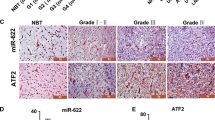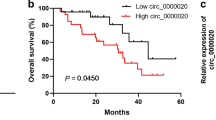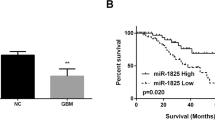Abstract
Objectives
To explore the effects of the competitive endogenous RNA (ceRNA) network between TP53INP1 and E-cadherin on the invasion and migration of glioma.
Results
TP53INP1 and E-cadherin mRNA and protein were significantly overexpressed in normal brain tissues compared with glioma tissue specimens and correlated with the grades of glioma negatively. The expression of TP53INP1 and E-cadherin were correlated positively. Patients with higher TP53INP1 or E-cadherin expression had longer overall survival. Moreover, TP53INP1 3′-UTR inhibited glioma cell proliferation, invasion and proliferation; Furthermore, the 3′-UTRs of TP53INP1 and E-cadherin harboured seven identical miRNAs binding sites, and TP53INP1 3′-UTR could increase the expression of E-cadherin and decrease the expression of vimentin thus repressing the epithelial-mesenchymal transition (EMT). However, the coding sequence of TP53INP1 could not increase the expression of E-cadherin and the inhibitory effect on EMT of TP53INP1 3′-UTR was reversed by the siRNA against Dicer.
Conclusions
TP53INP1 3′-UTR could inhibit the EMT, thus hindering the migration and invasion of glioma via acting as a ceRNA for E-cadherin.




Similar content being viewed by others
Change history
13 September 2023
This article has been retracted. Please see the Retraction Notice for more detail: https://doi.org/10.1007/s10529-023-03431-6
References
Cesana M, Daley GQ (2013) Deciphering the rules of ceRNA networks. Proc Natl Acad Sci 110:7112–7113
Chevrier L, Meunier AC, Cochaud S, Muller JM, Chadeneau C (2008) Vasoactive intestinal peptide decreases MYCN expression and synergizes with retinoic acid in a human MYCN-amplified neuroblastoma cell line. Int J Oncol 33:1081–1089
Esposito F et al (2014) HMGA1 pseudogenes as candidate proto-oncogenic competitive endogenous RNAs. Oncotarget 30:8341–8354
Fang L et al (2012) Versican 3′-untranslated region (3′-UTR) functions as a ceRNA in inducing the development of hepatocellular carcinoma by regulating miRNA activity. FASEB J 27:907–919
Filipowicz W, Bhattacharyya SN, Sonenberg N (2008) Mechanisms of post-transcriptional regulation by microRNAs: are the answers in sight? Nat Rev Genet 9:102–114
Grauer OM, Wesseling P, Adema GJ (2009) Immunotherapy of diffuse gliomas: biological background, current status and future developments. Brain Pathol 19:674–693
Karlsson E et al (2015) Loss of protein tyrosine phosphatase, non-receptor type 2 is associated with activation of AKT and tamoxifen resistance in breast cancer. Breast Cancer Res Treat 153:31–40
Li X et al (2016) STARD13-correlated ceRNA network inhibits EMT and metastasis of breast cancer. Oncotarget. doi:10.18632/oncotarget.8099
Ma H et al (2015) CCR7 enhances TGF-beta1-induced epithelial-mesenchymal transition and is associated with lymph node metastasis and poor overall survival in gastric cancer. Oncotarget 6:24348–24360
Pang H, Zheng Y, Zhao Y, Xiu X, Wang J (2015) miR-590-3p suppresses cancer cell migration, invasion and epithelial-mesenchymal transition in glioblastoma multiforme by targeting ZEB1 and ZEB2. Biochem Biophys Res Commun 468:739–745
Salmena L, Poliseno L, Tay Y, Kats L, Pandolfi PP (2011) A ceRNA hypothesis: the Rosetta Stone of a hidden RNA language? Cell 146:353–358
Shahbazi J et al (2014) Histone deacetylase 2 and N-Myc reduce p53 protein phosphorylation at serine 46 by repressing gene transcription of tumor protein 53-induced nuclear protein 1. Oncotarget 5:4257–4268
Wang H et al (2015) Upregulation of miR-181s reverses mesenchymal transition by targeting KPNA4 in glioblastoma. Sci Rep 5:13072
Yang J et al (2014) FOXO1 3′UTR functions as a ceRNA in repressing the metastases of breast cancer cells via regulating miRNA activity. FEBS Lett 588:3218–3224
Zheng L, Li X, Gu Y, Ma Y, Xi T (2014) Pseudogene CYP4Z2P 3′UTR promotes angiogenesis in breast cancer. Biochem Biophys Res Commun 453:545–551
Zheng L, Li X, Gu Y, Lv X, Xi T (2015) The 3′UTR of the pseudogene CYP4Z2P promotes tumor angiogenesis in breast cancer by acting as a ceRNA for CYP4Z1. Breast Cancer Res Treat 150:105–118
Zheng L et al (2016) Competing endogenous RNA networks of CYP4Z1 and pseudogene CYP4Z2P confer tamoxifen resistance in breast cancer. Mol Cell Endocrinol 427:133–142
Acknowledgments
We thank Prof. Wu for critically reviewing this manuscript.
Supporting information
Supplementary Table 1—Primer sequences used for the construction of the TP53INP1-3’-UTR and TP53INP1-CDS, and primer sequences for TP53INP1 and E-cadherin qRT-PCR.
Author information
Authors and Affiliations
Corresponding author
Ethics declarations
Conflict of interest
The authors declare no conflict of interest.
Electronic supplementary material
Below is the link to the electronic supplementary material.
About this article
Cite this article
Wang, Y., Lin, G. RETRACTED ARTICLE: TP53INP1 3′-UTR functions as a ceRNA in repressing the metastasis of glioma cells by regulating miRNA activity. Biotechnol Lett 38, 1699–1707 (2016). https://doi.org/10.1007/s10529-016-2159-3
Received:
Accepted:
Published:
Issue Date:
DOI: https://doi.org/10.1007/s10529-016-2159-3




